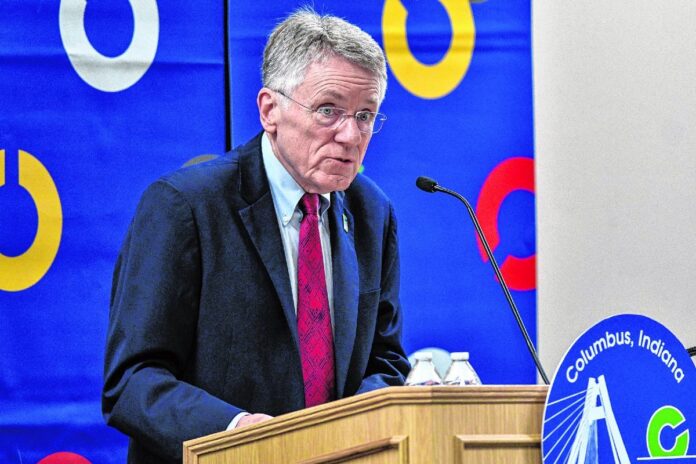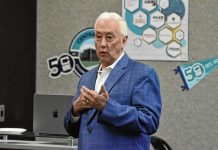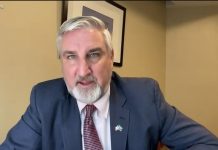
It has been a busy year.
That was one of the key messages Thursday night as Columbus Mayor Jim Lienhoop and Columbus Regional Health President and CEO Jim Bickel delivered updates on several major projects throughout the city at the mayor’s annual State of the City address.
Lienhoop’s and Bickel’s remarks were made before nearly 250 people who attended the annual address at the mostly-vacant FairOaks Mall located at the corner of Central Avenue and 25th Street.
During the address, Lienhoop spoke about several ongoing city projects — including the railroad overpass, riverfront redevelopment, downtown conference center, substance abuse initiatives, among others — while Bickel gave an update on the FairOaks Mall project and broad plans for the future investment and expansion by the hospital system.
[sc:text-divider text-divider-title=”Story continues below gallery” ]Click here to purchase photos from this gallery
“It is an exciting time to be in Columbus,” Lienhoop said. “Frankly, I tell people that it is a great time to be mayor. We have much to work with and much underway, and we have a civic spirit second to none.”
The projects
Lienhoop gave a brief update on the railroad overpass and interchange project on Columbus’ west side that will allow motorists to avoid being stopped by railroad traffic at the intersection of State Road 46 and State Road 11.
Construction crews from Milestone Contractors have wasted little time getting started on the estimated $35 million project that is being jointly funded by the Indiana Department of Transportation, city of Columbus, Bartholomew County, Cummins Inc. and the Louisville and Indiana and CSX railroads.
The mayor, however, drew attention to a consequence of increased railroad traffic through the city — more trains means more train horns.
Lienhoop said the city is looking into creating a “quiet zone” at the four local crossings, State Road 46 and Fifth, Eighth and 11th streets.
Under federal regulations, train conductors are required to sound the train’s horns in a “standardized pattern of two long, one short and one long blasts,” according to the Federal Railroad Commission, which regulates railroads in the United States.
A quiet zone removes requirements to sound horns at crossings, but would require upgrades at the crossings, including gates and center line dividers.
“The pattern must be repeated or prolonged until the lead locomotive or lead cab car occupies the grade crossing,” according to the commission.
In Columbus, every train is required to sound its horn 16 times, four times at each of the four crossings, Lienhoop said.
“We’ve engaged traffic engineers to help us understand what those safety enhancements will mean in terms of cost and revisions to the intersections,” Lienhoop said. “We’ve also engaged the railroad in these discussions, as they are the ones who will construct the safety improvements. We’re awaiting their analysis.”
Future CRH expansion
Bickel spoke about CRH’s “continued investment” in new facilities, community partnerships and the hospital system’s own programs and services.
In recent years, CRH has purchased the former Clarion Hotel and Conference Center on the city’s west side, an 800-acre property in the Garden City area and a portion of the nearly vacant FairOaks Mall.
Currently, those projects are in varying stages of planning, Bickel said.
CRH has hired a multi-disciplinary team tasked with developing an actionable design for the health system’s portion of FairOaks Mall.
The team includes engineering firm Smith Seckman & Reid, architecture firm BSA Lifestructures, interior design firm RSP Architects and Turner Construction.
“We envision an array of physician and other outpatient services co-located and integrated to provide easy and convenient access to services without having to visit multiple locations around the community,” Bickel said. “We anticipated that the design and final programming work will be completed later this year.”
Bickel also touched on the former Clarian site, which he acknowledged “is taking longer than anticipated” to rehabilitate, and the farm property between Garden City and Interstate 65, which “will provide (CRH) long-term opportunities to design a health and healthcare campus,” but did not offer specifics.
“We also know our main facility on 17th Street is aging and our campus has limitations making expansion and further renovation difficult and costly,” Bickel said. “It also makes its adaptation to future needs challenging.”
Substance abuse efforts
Lienhoop briefly spoke about the Alliance for Substance Abuse Progress (ASAP), which he said is a “real success.”
Launched in 2017, ASAP is a community-wide response to address addiction, including the opioid crisis, in Bartholomew County. ASAP formed through a partnership of Columbus and Bartholomew County governments and Columbus Regional Health.
Last year, the ASAP Hub opened in the Doug Otto Center, 1531 13th St., which is seen as a crucial component to the strategy of addressing substance use disorder locally.
The Hub is a 2,000-square-foot recovery resource center for individuals, families and friends who are impacted by substance abuse disorder.
Currently, the Hub sees around 10 to 12 people per day, Lienhoop said.
“ASAP is a real success,” Lienhoop said. “I think I can speak for our partners, as well as the city, when I say that, while we know there is a lot of work to do, we are exceptionally pleased with the progress to date.”
‘High-tech’ approach
Lienhoop also announced that Columbus residents in early May will be able to schedule pickups via a mobile app for large items that are hard to dispose of, such as furniture, appliances or electronics.
“We also plan to take garbage high tech,” Lienhoop said. “…Curb It is an app for your phone that will allow you to schedule large items for pickup — items like couches and mattresses. It will also provide an option for hard-to-recycle electronics and white goods like dishwashers.”
Some items will be picked up for free, while others may require a charge, Lienhoop said.
The app will not replace the city’s current recycling services, Lienhoop said.
Other projects
Lienhoop also spoke briefly about a proposed riverfront redevelopment project that could include removal of the lowhead dam in the East Fork White River downtown, repair of the river banks and opportunities for recreation.
Lienhoop said progress is being made “slowly.”
“We have an old, unsafe, falling apart dam that was built cock-eyed to the river,” Lienhoop said. “We have erosion on both sides of the river. On the west side, erosion threatens to expose an old landfill. On the east side, erosion has already exposed an active sewer pipe.”
The project, however, also includes “in-water recreation, a safe People Trail connection and a beautiful extension of Mill Race Park,” Lienhoop said.
Lienhoop also said he anticipates giving an update by the end of May on potential plans for a hotel/conference center, mixed-use residential development and grocer along the Second and Third Streets downtown.
‘Get educated’
Lienhoop closed the address by calling on members of the community to “get educated” about an operating referendum proposed by the Bartholomew Consolidated School Corp.
The school corporation is seeking voter approval in the May 5 primary for an operating referendum projected to generate around $7.8 million per year in additional property tax revenue to fund teacher and support staff salary increases and student safety.
“It is never easy to consider a tax increase,” Lienhoop said. “It is never easy to agree to pay more. But the purpose and the benefit could not be clearer. Our teachers need better compensation.”
If approved by voters in May, the referendum would increase BCSC’s property taxes by $0.156 per $100 of assessed value to roughly $1.01 starting in 2021. BCSC officials initially had sought a $0.195 per $100 of assessed valuation increase, but lowered the request before the public information sessions began.
A total of 86% of the increased property tax revenue would be spent on employee recruitment and retention and 14% on student safety and security, according to figures from BCSC.
“Today, we are losing teachers to other schools and other professions. And, the pool of those studying to become teachers in Indiana is less than half what it was 10 years ago,” Lienhoop said. “Folks, we tell ourselves we wish to be the best community of our size in the country. We cannot do that without the highest quality police officers, firefighters and teachers.”
[sc:pullout-title pullout-title=”For more photos” ][sc:pullout-text-begin]
For more photos, see therepublic.com.
[sc:pullout-text-end]




